Arth 3620 Final Exam Study Images
1/21
There's no tags or description
Looks like no tags are added yet.
Name | Mastery | Learn | Test | Matching | Spaced |
|---|
No study sessions yet.
22 Terms
Realism (1840s–1870s)
Focused on depicting everyday life and working-class subjects with fidelity to real experience.
Impressionism (1870s–1880s)
Art movement focusing on capturing light and everyday scenes with loose brushwork and vibrant color.
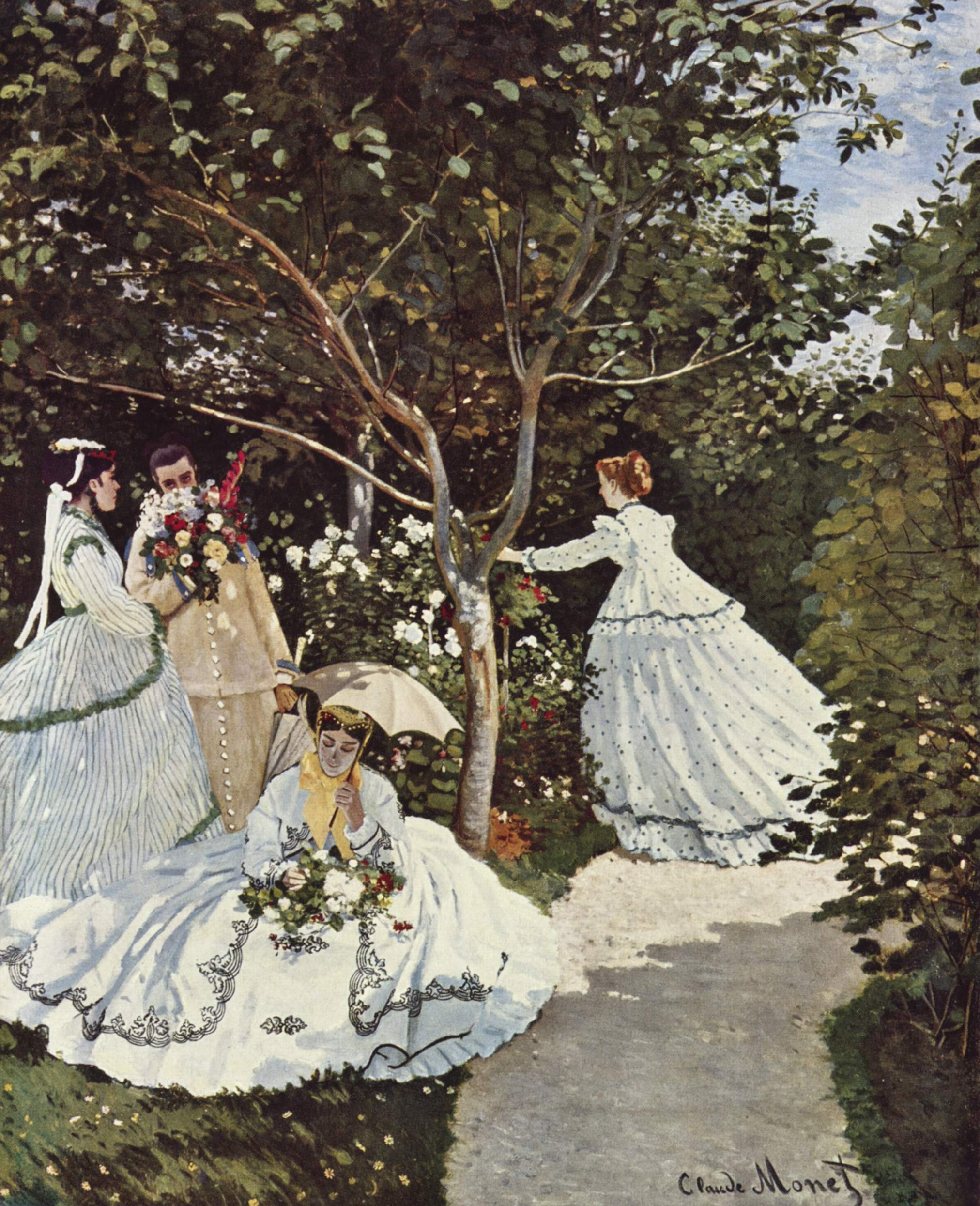
Monet, Women in the Garden, 1866
Monet depicts several women, modelled by his companion Camille who enjoy the garden space at his rented home. Painted when Monet was experimenting with large-scale outdoor figure painting, which was unusual for the time. It was submitted to the Salon of 1867, where it was rejected because the brushwork appeared “unfinished” and too visible, the figures lacked polished modelling expected in academic art and the focus on natural light effects instead of clearly defined forms was considered improper. This painting contains impressionist elements. The narrative of the painting itself is of ordinary women rather than idealised heroic scenes. The composition crops some of the figures, influenced by photography, and helps capture the vibe of the monetary scene. Like in the women’s dresses absorbing green light filtered through the trees, showcasing the impressionist preoccupation in how natural light alters colour. Through the use of complementary colours placed next to each other seen in the contrast of the yellow and violet on the skin. Monet’s use of Tache which are visible patches of colour that indicate light. The painting was painted in plein air.
Can be compared to:
Morisot, Young Woman Watering a Shrub, 1876
Both depict women outdoors, engaged in everyday, domestic activities. Both use cropping influenced by photography. Both rely on soft, loose brushwork, especially in the treatment of foliage. Morisot’s painting is fully Impressionist, while Monet’s is transitional.
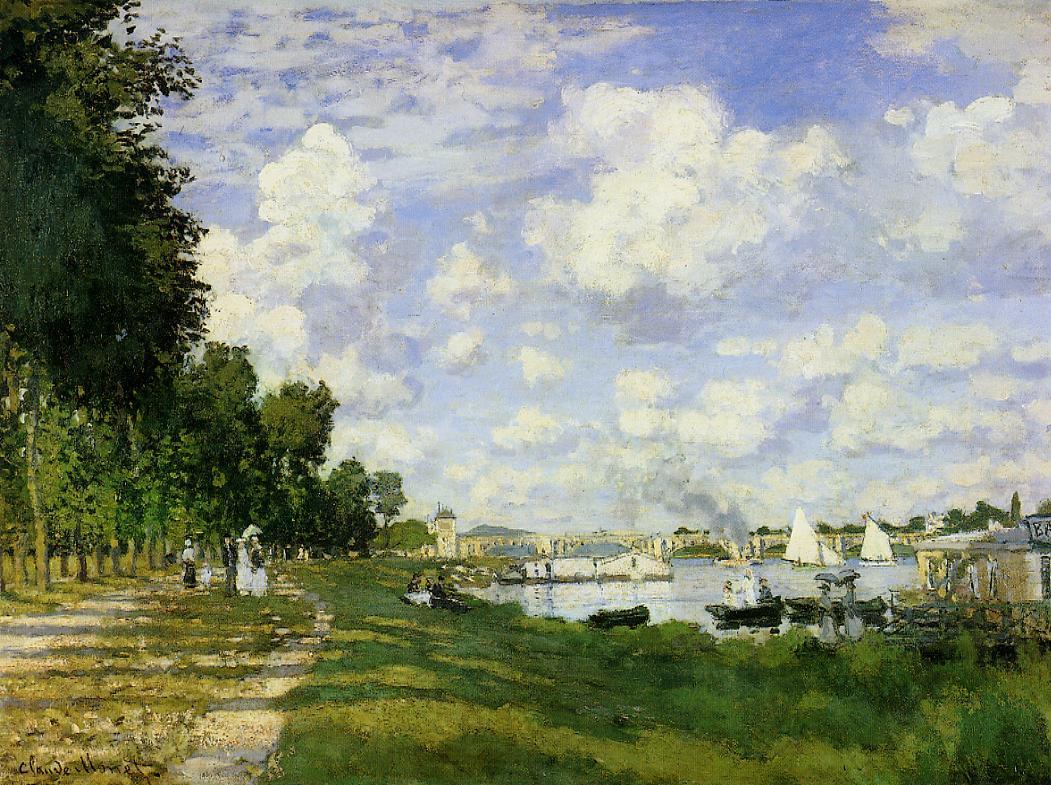
Monet, The Basin at Argenteuil, 1872
An innovative landscape painting of Argenteuil in which figures stand on the right side as others sail on top boats on the left in the La Seine River. Painted during Monet’s residency in Argenteuil. Reflects the post–Franco-Prussian War period when Parisians sought leisure and escape from recent violence, making Argenteuil a symbol of modern suburban relaxation as it was a short distance from Paris that required only a train ride. Argenteuil became a subject for Impressionists because of its association with leisure. The painting contains many impressionist elements. There is emphasis on light, especially on the water and sky, which dominate the composition, making the figures look small in comparison. Use of tache (dabbed, broken brushstrokes) to capture flickering reflections on the water. An absence of clear contour lines; forms blend into one another, causing the green to not fade from foreground to background. The sky takes up a large portion of the canvas, showing the Impressionist priority of light over subject matter. Depiction of modern leisure, seen with the women holding a parasol, indicating her class status as bourgeois. This reflects Impressionists’ interest in capturing contemporary life.
Can be contrasted with:
Manet, Argeteuil, 1874
Manet depicts two people (a man and woman) in conversation, using their posture and gestures to suggest tension or intimacy. Monet uses Argenteuil to explore light, sky and water, making nature the main subject as the human figures are present but small, distant, and secondary to the setting. While Manet, uses the same location to explore human relationships, emphasizing social interaction and psychological tension. In which, the figures are large, close, and central, making the painting more about social behaviour than the landscape.
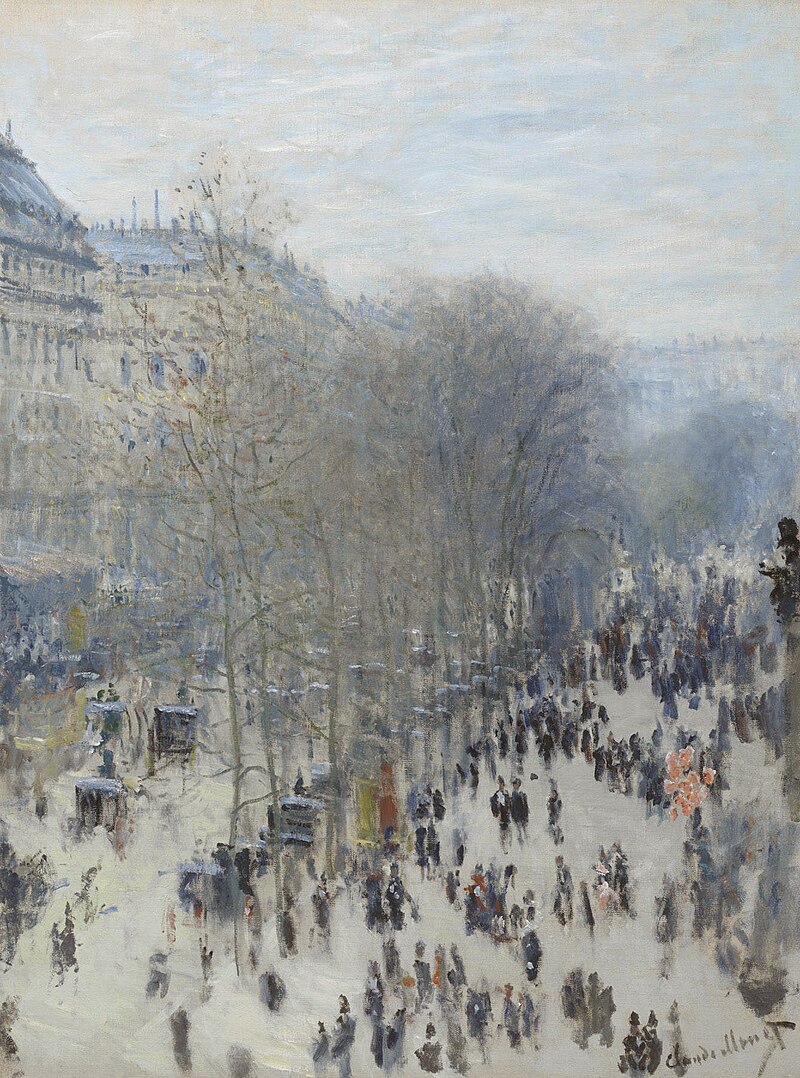
Monet, Boulevard des Capucines, 1874
The subject of the painting is crowds moving along a Paris boulevard, captures the new urban life created by Haussmann’s renovations, showing modernity as a visual experience rather than a structured narrative. The streets of Paris are captured from a balcony, a liminal space between private and public which is an impressionist preoccupation. The painting is historically significant as it was shown in the First Impressionist Exhibition in 1874. There are many impressionist elements. The use of small but visible brushstrokes to capture movement and the fleeting effects of winter light through restrictive colours. The composition is cropped, resembling a photographic snapshot. People in the crowd are rendered as blurs or splotches of colour, which Leroy and other critics disparaged many abstract artists by referring to their brushstrokes as “tongue lickings”. Instead of clear outlines or academic detail, Monet prioritizes light and motion to capture the moment in time.
Can be contrasted with:
Caillebotte’s Paris, A Rainy Day, 1877
Which depicts as the title states a rainy day in Paris in which there are multiple figures holding umbrellas wandering the streets. Caillebotte represents Paris with sharp, realistic lines and clear figures. Monet represents Paris with dissolved forms, prioritizing light and optical perception. Caillebotte’s work is Realist-Impressionist hybrid; Monet’s is pure Impressionism. Caillebotte emphasizes composition and perspective; Monet emphasizes fleeting sensation.

Renoir, Le Pont des Arts, 1867
Painted during Renoir’s early career, before the first Impressionist exhibition. Depicts modern Parisian subjects like the bridges, boats, new architecture from Haussmann's transformation of Paris. There is a soldier present who represents the state's power, as the core reason for the transformation of Paris was to prevent uprisings. In the viewer there are silhouettes of pedestrians walking on the bridge. Infront is a docking area from which tourists are boarding and to the right is the Dome to represent the weight of history. By showing boats on the Seine, new architecture, and pedestrians crossing the bridge, Renoir captures how Haussmann’s renovations had turned Paris into a modern tourist destination. The painting represents the idea of the flâneur, an observer who wanders the city as a spectator of modern life. There are many impressionist elements present. The subject of this painting is reconstructed Paris, a modern space. The brushstrokes are visible, an effort is being made to capture the light as it hits different surfaces, such as the water and the building in the back. There is a realist element such as paying attention to the everyday subjects like the soldier.
Can be compared to:
Manet, Music in the Tuileries (1862)
Both portray crowds in modern Paris, enjoying leisure created by Haussmannization. Manet offers clearer individual figures; Renoir offers silhouettes and a gentle atmosphere. Both highlight the rise of the Parisian bourgeois leisure class.
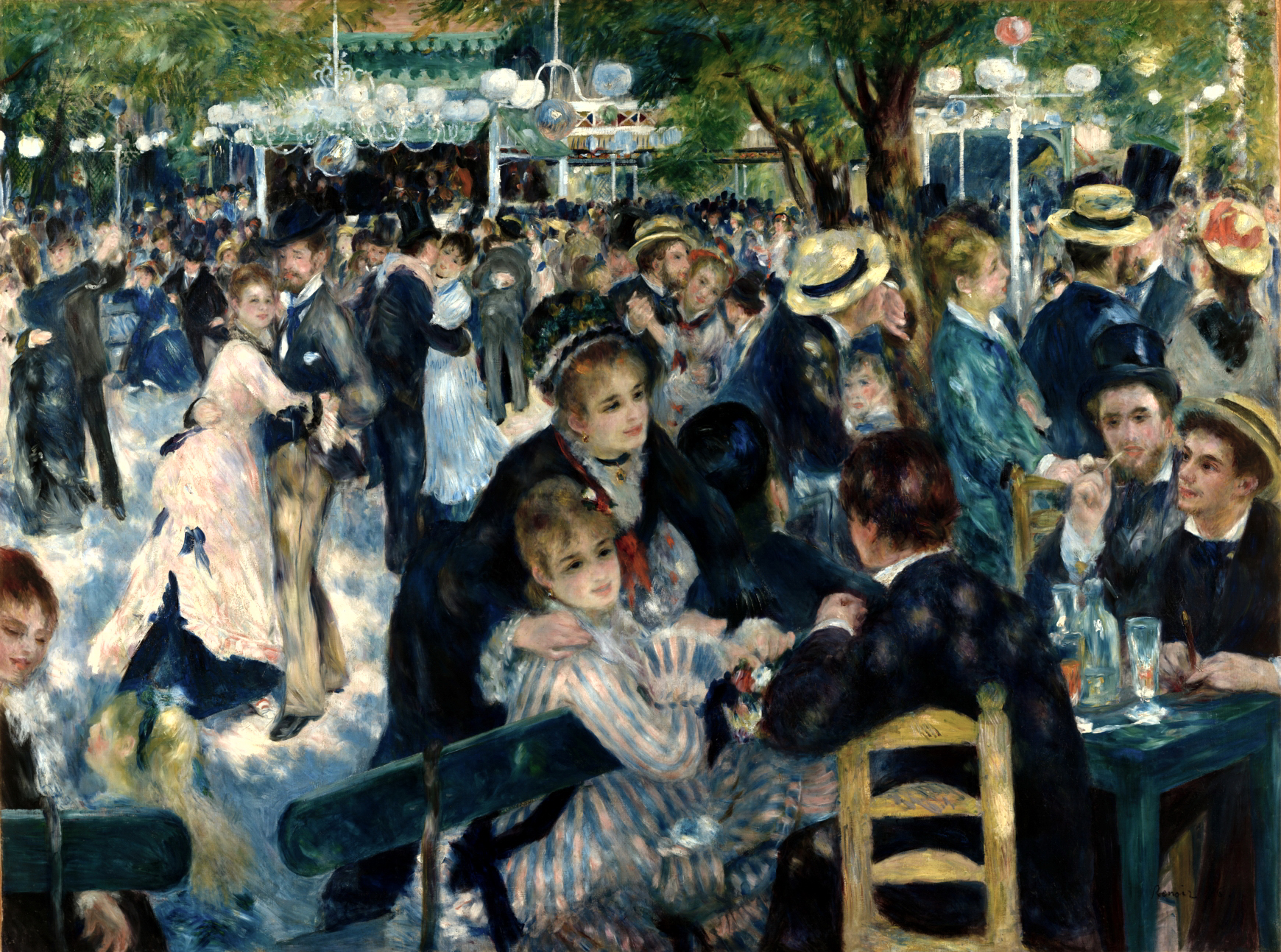
Renoir, Moulin de la Galette, 1876
This painting depicts a dance at the Moulin de la Galette, a place Renoir and his friends frequented. This is an Impressionist piece. Depicts the working and lower-middle-class leisure culture in Montmartre, an important shift away from elite subjects toward everyday Parisians. There are many figures either dancing or sitting for a conversation, no one is the central focus rather the moment outdoors is. This can be seen as the eye moves further into the background, figures blur into motion, their faces are half-hidden by dappled shadows. Special attention is paid as to how the light filters through trees onto faces, hats, dresses, and the dance floor. The forms are loosely rendered by visible brush strokes. This includes the figures, their clothing and hair, as well as the environment like the leaves and wood. The composition is likely inspired from photography. This painting features Renoir's friends and models he used for paintings in the right corner of the composition. This was an effort to capture his artistic mission.
Can be compared to:
Courbet, The Studio of the Painter, 1855
Depicts Courbet surrounded by models, friends, and critics; allegory of his artistic world. College-like structure, unfinished areas, and symbolic objects. Courbet paints modern people in a large-scale scene, with a political message. However, Renoir paints modern people on same-scale, but focuses on pleasure, light, and optical sensation. Shows how Impressionism abandons Realist moral critique for sensation and immediacy.
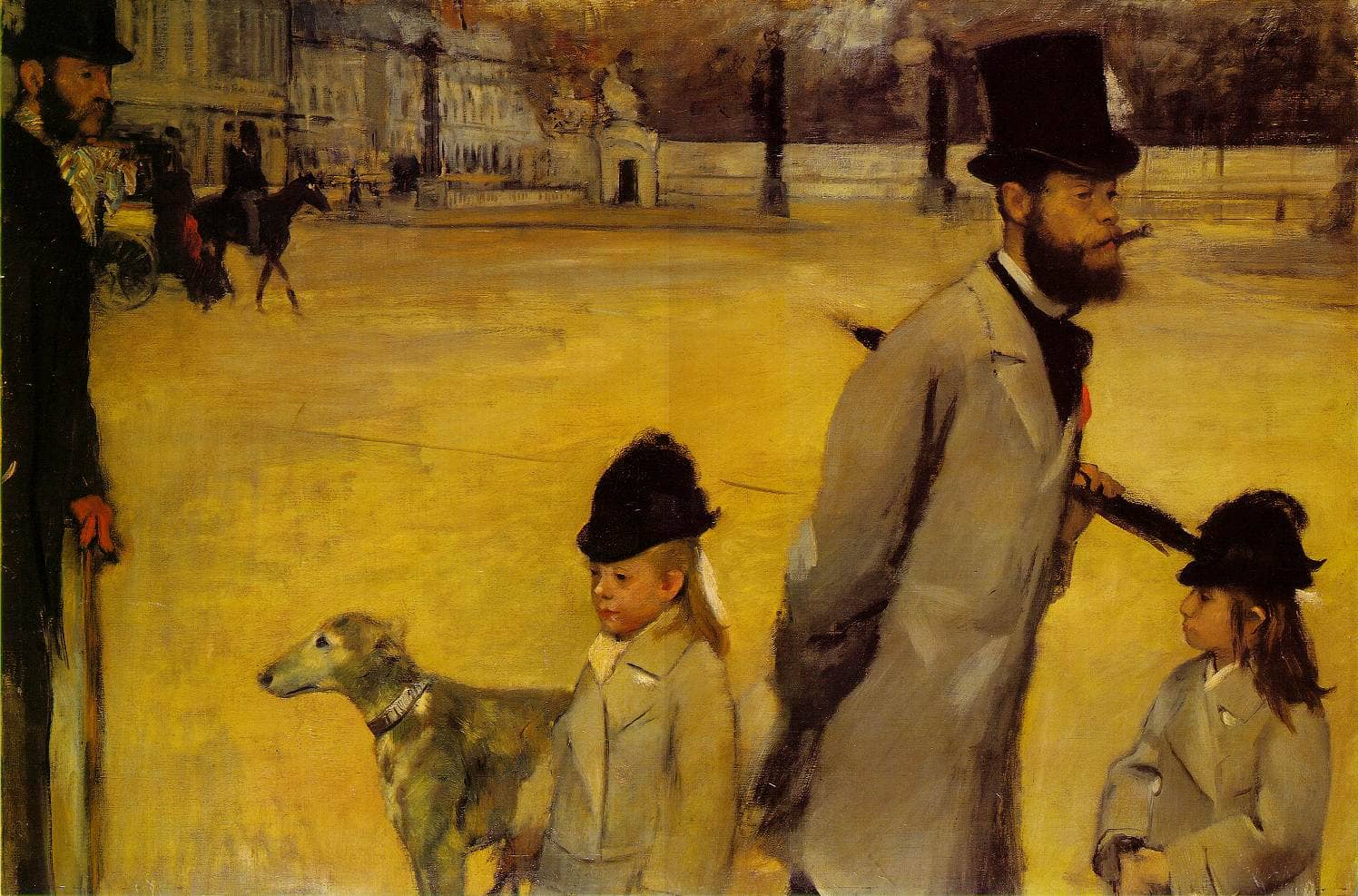
Degas, Place de la Concorde, 1875
Painted after the Franco-Prussian War and the Paris Commune (1870–71), when Paris was rebuilding itself. Depicts a friend of Degas’s Count Lepic, his daughters, and other figures walking across Place de la Concorde, a major public square transformed by Haussmann’s modern urban design. The count is depicted as a Flaneur, he wears his light walking coat and walks with an umbrella clenched under his arm, like a defensive gesture. He is indifferent even to his own children and dog. This is an impressionist work. The composition is cut off, the umbrella looks like it's passing behind the girl's head, inspired from japanese woodblock print. The space is odd, the three figures form a triangle and the space is flattened. This is a perceived sensation of movement as the man to the left looks to be caught mid stride. The colour palette is very restrictive using colours reminiscent of Realism. However the brushstrokes are impressionist as they are visible and create movement to capture the light.
Can be contrasted:
Renoir, Moulin de la Galette, 1876
Renoir shows joy, warmth, community, and dancing. Whereas Degas shows isolation, disconnection, and urban indifference. Renoir’s crowd is intimate; Degas’s figures don’t interact or even look at each other. Renoir celebrates leisure; Degas documents the modern city’s coldness.
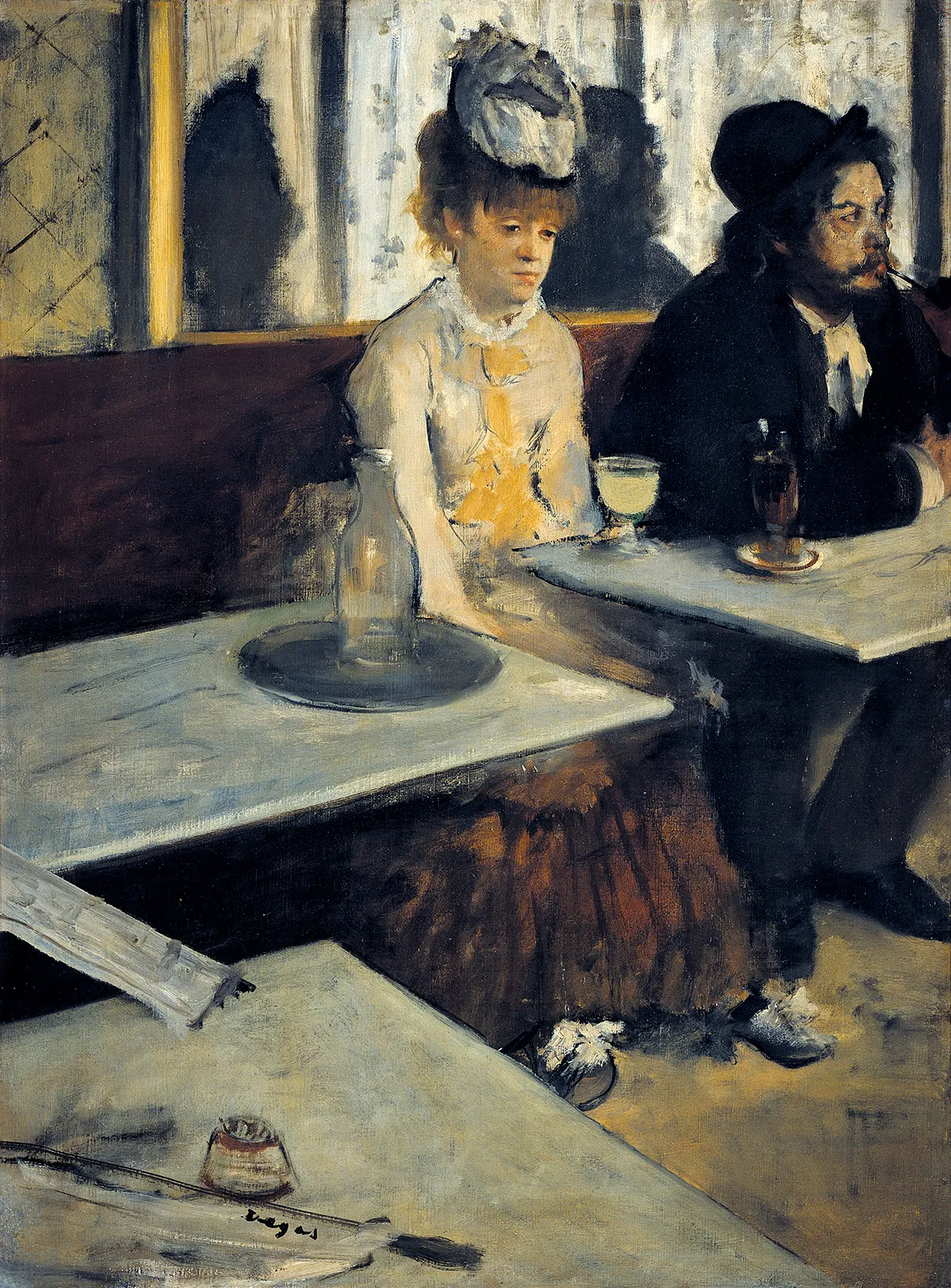
Degas, Absinthe, 1876
Depicts a man and woman sitting at a table with drinks and looking depressed. This is meant to be read as a social type, depicting the social issue of absinthe alcoholism, a major public concern in the 1870s. The female figures shoulders are slumped, feet set apart, she seemingly a regular in the cafe. There is grey light shining onto the lace curtains behind the figures that represent the morning after a night out. But also represents a source of reflection. Women who are succumbing to alcoholism, Degas is approaching this scene with detachment, this is the new Paris. The table has no legs giving the illusion of it floating, purposeful abstraction to give tension to the composition. The foreground contains a container of matches as if they are for the viewer. The newspaper is a bridge to the other table, the man and women show no interest in each other or reading. This painting is meant to represent loneliness of city life despite the café being a social space.
Can be contrasted with:
Lungren, The cafe, 1884
In contrast, Lungren’s The Café (1884), painted by an American artist in Paris, adopts a far more traditional and reassuring approach: the tables are arranged in neat parallel rows, the perspective is stable, and the sharp, consistent focus creates a calm and orderly atmosphere. Where Degas unsettles the viewer and reveals the darker realities of modern existence, Lungren offers a pleasant, conventional, and socially cohesive vision of café culture from a safe distance.
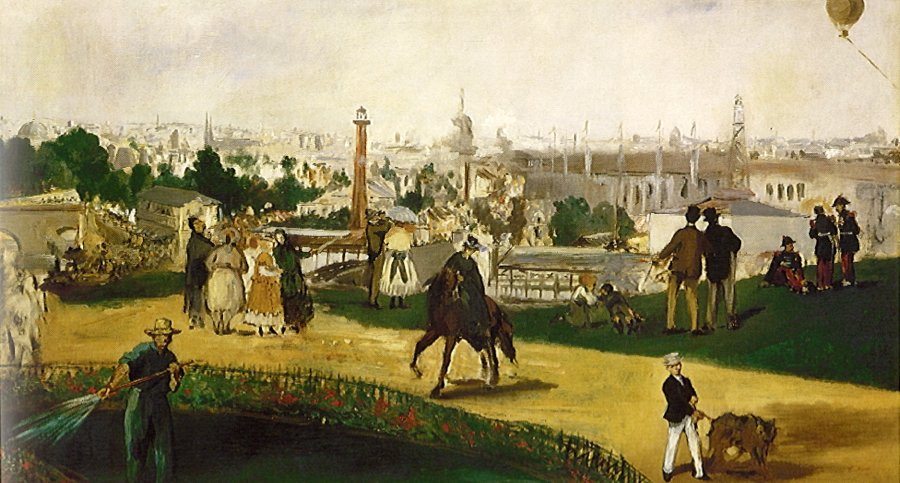
Manet, View of the World's Fair, 1867
Impressionist work on a large composition of the Paris World Fair. Held by Louis Napoleon to showcase modernity and industrial prowess during the french world fair. The fair was a propaganda event for Napoleon III’s France. By painting it with a muted palette, distant figures, and a strangely empty middle ground, Manet quietly critiques the emptiness of imperial modernity. The viewer is physically distanced from the event. This was painted from Manet's balcony, which informs the perspective. Near the location of where soldiers were trained who persecuted artists and intellectuals. The soldiers are to the right side wearing bright red pants showing that soldiers are omnipresent. There is the presence of gutters which were thought to be dirty by society. Nadar, a photographer who influenced many impressionists, is shown in the hot air balloon to the top left, which informs the composition itself in the painting as it is cropped. Hidden behind the slope is the Le seine river as it did not hold the same meaning anymore. The perspective is flattened, near the left side is a blue collared worker. On the left are working class individuals. To the right are lower bourgeoisie and the ones with the back facing us are higher bourgeoisie. There is a woman on the horse which was uncommon for a woman to ride alone as they would be dubbed amazonian. This is evidence of gender politics. Orderly diagonally “X”.
Can be contrasted:
Renoir, The Champs Elysees during the Paris World Fair, 1867
In contrast, the viewer is directly in the lively boulevard, emphasizing the glittering lights, fashionable crowds, and festive atmosphere. Renoir celebrates Paris as a radiant center of modern culture, while Manet offers a cool, observational, and even skeptical image of modern spectacle.

Manet, Masked Ball at the Opera, 1873
An impressionist work that depicts one of the most famous social events of the Second Empire, the masked balls at the Paris Opéra during carnival season. They were a space for partying and naughty things as both the bourgeoisie and courtesans could mix. The composition contains bodies cut off at the edge with no focal point. The Opéra is lit by gaslight, producing shifting tones and reflections. Manet captures this sophisticated, modern indoor light with loose brushwork. Colour patches create shimmering impressions rather than detailed description of the forms. Such as the clothing of the masked attendees and the hall's architecture. He represents his friends showing himself to be a member of this class but also an observer, a flaneur.
Can be compared to:
El Greco, Burial of Count Orgaz, 1586
Depicts the burial of Count Orgaz being lowered into his tomb as he is surrounded by clergy and nobles, but also above him are saints, angels and Christ who oversee the funeral procession. The crowd is orderly, solemn, and focused on a central devotional event. In contrast, Manet’s Masked Ball at the Opera (1873) shows the chaos and theatricality of modern urban nightlife. The crowd is fragmented, bodies are cropped, masks obscure identity, and artificial gaslight highlights social play rather than spiritual meaning. Where El Greco offers a clear narrative of salvation, Manet offers a swirling spectacle of flirtation, anonymity, and modern performance.
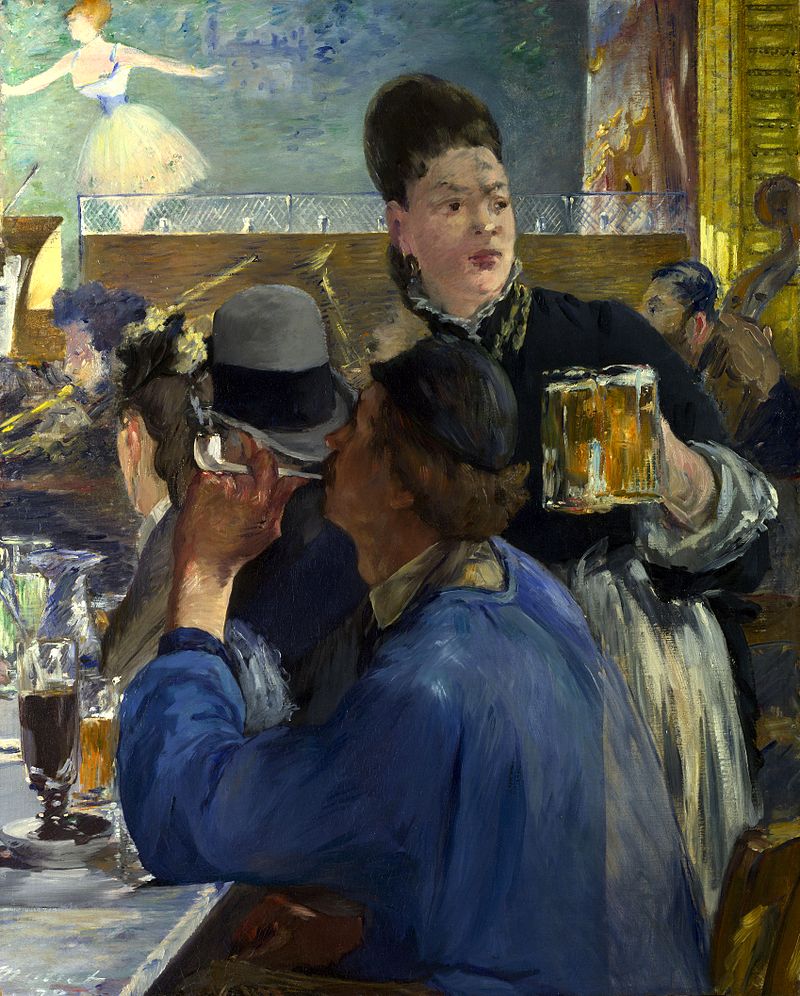
Manet, Corner of a Café-Concert, 1879
An impressionist work depicting a barmaid carrying beer for customers, as a man in the forefront smokes a pipe, while watching a woman perform in the background. By the late 1870s, Paris cafés, cabarets, and café-concerts were central to modern social life. The only realist element is the barmaid working and the performers in the background. The composition is cut off, like a photograph. The light is one of the main focuses as the gaslight from the performance bounces off the beer pitchers, glass, fabric, and skin. The figures in the background blend into each other through the use of cooler colours. This painting was meant to depict modernity’s mixture of labor and leisure.
Can be compared to:
Manet, A Bar at the Folies-Bergère, 1882
Depicts a young woman working at a bar serving a male bourgeois customers. Both paintings depict working class women serving bourgeois men. Has the same themes of performance, modern spectacle and gendered labor. Both blur reality vs. illusion.
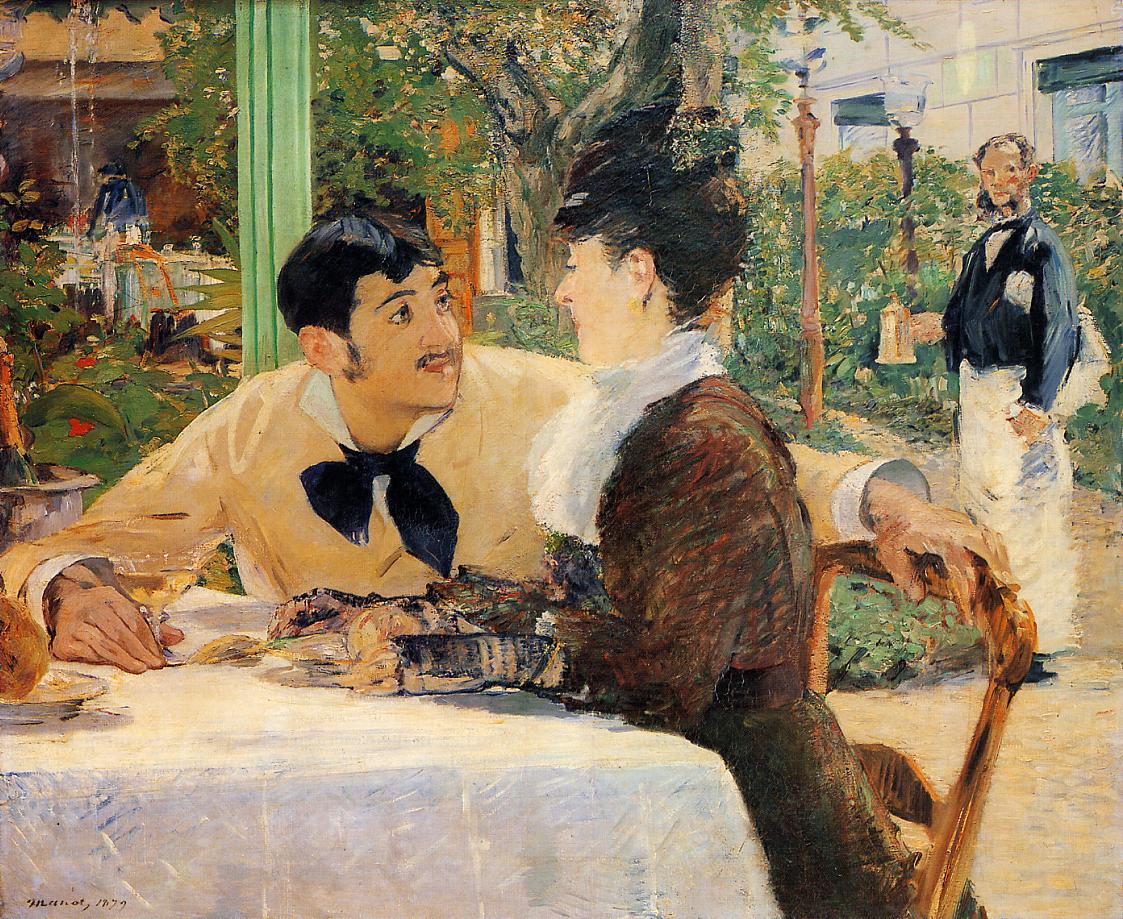
Manet, Chez le Père Lathuille, 1879
Painted in the outdoor garden of a popular Paris restaurant, where Manet and Impressionist artists often gathered. Depicts a modern scene of public bourgeois flirtation. A man leans into the female figure, resting his left hand on her chair in an effort to prop himself and right hand grabbing her wine glass. His actions make him aggressive and territorial as he tries to woo her. The woman seems to be interested but taken aback by the man's actions. She sits with her back straight and hands resting on the dinner table. In the background is a server standing with a coffee pot who is unsure of if the affections are being reciprocated. The pair in the front’s clothing define their class as bourgeois. Namely, the silk jabot around the woman's neck and the man's pale yellow beige suit. There are many impressionist elements in this painting. The painting was en plein air, at the restaurant in broad daylight. The light seems to be focused as the bright colours break to capture light filtering through the trees, soft shadows and warm skin tones. There are visible brushstrokes seen all throughout the composition, most obvious would be the women's dress, the servers apron and the foliage. The subject itself is modern at a cafe as two people engage in casual flirting. The moment also feels real rather than posed.
Can be compared to:
Renoir, Lunch at the Restaurant Fournaise, 1875
Both Manet’s and Renoir’s paintings depict modern Parisian leisure in bright outdoor settings, using Impressionist light and colour to capture the modern social life. Renoir portrays group boating culture along the Seine, emphasizing cool coloured group sociability. Manet’s scene is more intimate, centering on a flirtatious exchange between two figures, making his version quieter, more narrative, and more attentive to subtle bodily gestures.
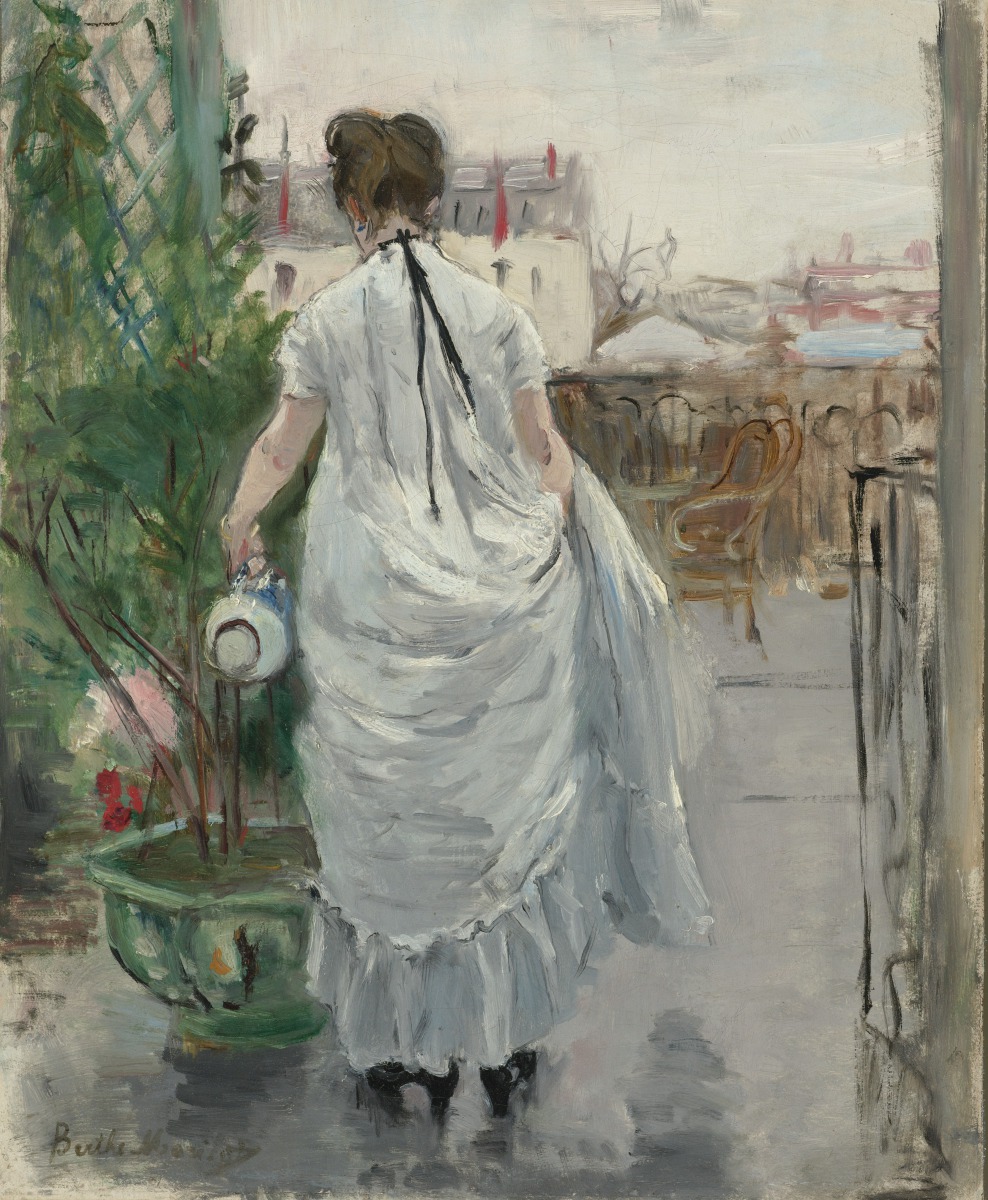
Morisot, Young Woman Watering a Shrub, 1876
This is an impressionist painting of Edma, Morisot's sister watering a shrub, gentle domestic labor, a woman tending the small natural worlds allowed to her. There is a sense of vulnerability as the figure is in casual dress. As bourgeois women could not freely roam public spaces like male Impressionists, Morisot sought liminal spaces that were private but also public. Depicts Edma holding her skirt as she waters, attention to everyday medial tasks, a realist quality. The painting captures the moisture in the air after rain accurately through the soft colour palette of whites, greens, pale blues and soft pinks. This is also captured through the reflections on the pavement as there are remnants of water still present. The brushstrokes are radical as they change to depict different lighting conditions. As the viewer is not engaged with the figure, the viewer is made to look at the grey landscape behind. The brushstrokes are loose, using a combination of warm and cool grey with touches of white in the dress. There is a blurring of iron bars meld into the background and foreground due to the shallowness of the composition. The figure is pouring into a large porcelain pot, which has Japanese influence reflecting the public craze. Has influence from photography seen in how the composition is cropped. Her techniques consisted of wet on wet paint. The figure is shown in an honest way rather than sexually associated with many other subjects. The softness of the brushstokes could be translated to be a tenderness to her sister.
Can be contrasted:
Caillebotte, Luncheon, 1876
Morisot presents a domestic life as gentle, and active, showing a woman engaged in everyday work within a sunlit garden. In contrast, Caillibotte depicts a private interior filled with melancholy and ennui, with figures dressed in black after his father’s recent death and a central woman who appears emotionally withdrawn. The cut-off plate and knife draw the viewer into the tense atmosphere, emphasizing intimacy rather than leisure. While both artists break from the Impressionist focus on public pleasure spaces, Morisot shows domesticity as nurturing and light, whereas Caillebotte portrays it as heavy, still, and psychologically charged.
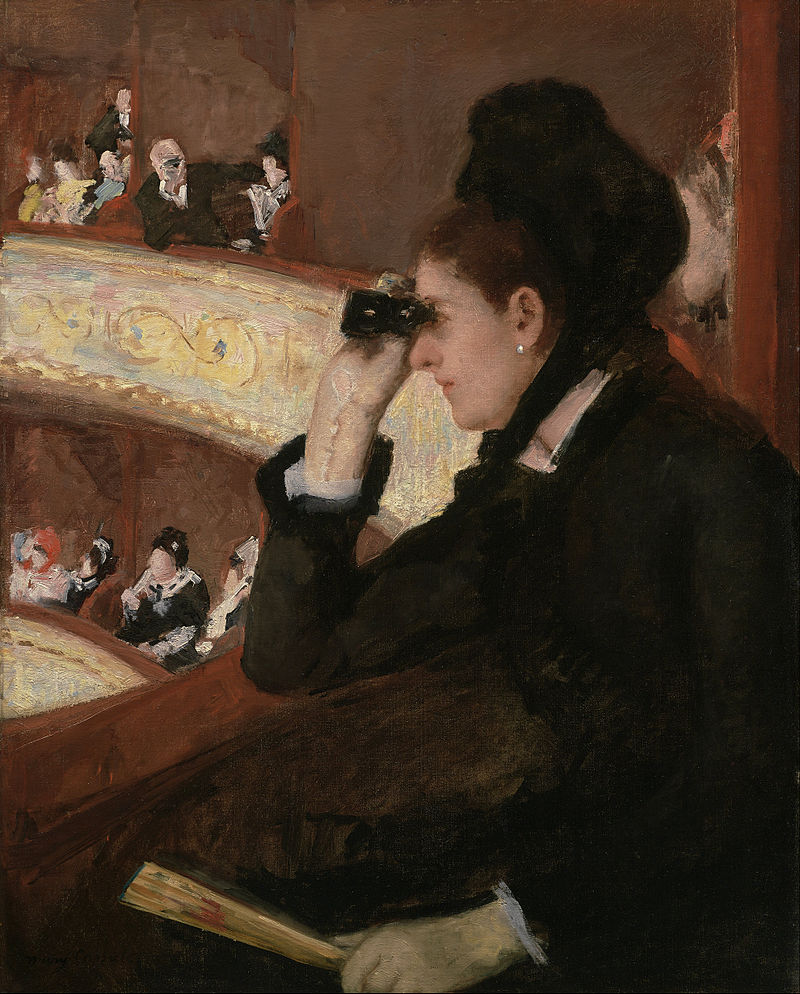
Cassatt, Women at the Opera, 1878
Depicts a woman leaning over the stand using binoculars in opera to view a performance or person as a man from another exaggeratedly leans out of his own box and uses his own binoculars to stare at her. This painting is central to discussions about women’s agency, looking, and being looked at in 19th-century Paris. There are many impressionist elements. The woman is viewed from a close, slightly off-center angle. Parts of the scene and other spectators, balconies, edges of bodies are cut off. This mimics how a viewer might quickly glance around the opera house, emphasizing immediacy. The opera house is lit by gas lamps, 19th-century technology which Cassatt brushwork captures through the shimmer of lights on silk, the sheen of the woman’s dress and the soft, scattered glow of the opera interior. Impressionism is an art of perception, and Cassatt shows this by the woman engaging in the act of viewing.
Can be contrasted:
Renoir, La Loge, 1874
Can compare the representation of the women. Depicts a woman dressed in luxurious upper bourgeois clothing facing the viewer with a smile as a man behind her looks around with his binoculars. In Renoir the woman is being consumed by the viewer. Whereas in cassatt the woman is empowered because she is using her gaze. However, she is also being observed by a man in the back and she is willfully ignoring it. Renoir's subject looks as though she could be placed in any scene and give the same effect. Cassatt's figure is interacting with the scene. Cassatt was responding to Renoir.

Cassatt, At the Theatre, 1879
An impressionist piece depicting a woman, the artist's sister seated at the Opera in a pink evening gown with a mirror behind her to reflect society. Cassatt was interested in these spaces because women were becoming regular in these leisure spaces. The woman is shown extremely close-up, her head and body partially cut by the frame. Background balconies are also cropped and compressed. The subject is there with confidence because she is aware that she is an object for men' s consumption. The woman sits at ease, meaning back on her right elbow. The subject is used as a model for the proper behaviour for young ladies. Her use of artificial light is very advanced, described through loose strokes that suggest figures' faces. The artist relates to the subject as she is the only detailed figure while the rest are blurred. There is reflection captured in the pearls as well. The colour palette is bright to represent the artificial light. The warmer the form looks in the light and looks cooler in the shadows.
Can be contrasted:
Renoir, La Loge, 1874
Can compare the representation of the women. Depicts a woman dressed in luxurious upper bourgeois clothing facing the viewer with a smile as a man behind her looks around with his binoculars. In Renoir the woman sits up straight to be consumed by the viewer. Whereas in cassatt the woman leans back, aware that she is being consumed but does not care. Renoir's subject looks as though she could be placed in any scene and give the same effect. Cassatt's figure is interacting with the scene. Cassatt was responding to Renoir.
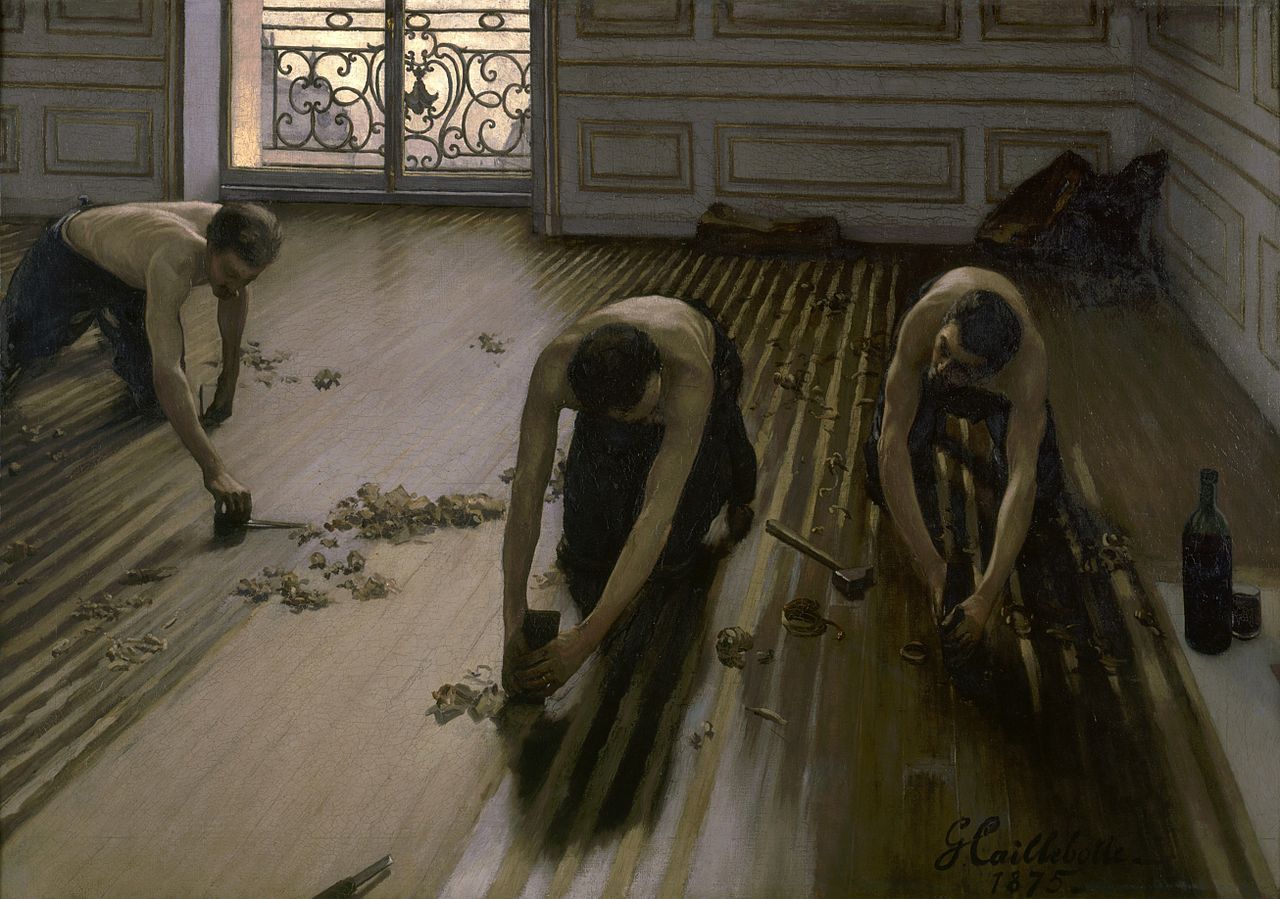
Caillebotte, The Floor Scrapers, 1875
Depict shirtless working class men who are scrapping an expensive apartment's wooden floors. The men working here could never afford to live in this apartment. It monumentalized working-class laborers on a large-scale canvas usually reserved for myth or history. The subjects, shirtless male workers, were considered “vulgar” and inappropriate for high art. This rejection helped cement Caillebotte’s reputation as a radical modern painter. Unlike Impressionists who painted café culture, boating, and parties, Caillebotte chooses laborers performing a physically demanding task. This is extremely Courbet-like Realism. The workers’ torsos are muscular, sweaty, and naturalistic, no heroic poses, no mythic idealization. However, the viewer is made to feel as present in the room, not an element in Realist artworks. There is an impressionist focus on light seen through the big Haussmannian window that floods the room with pale daylight. This is seen from the reflections on the scraped floor, the balance of light and shadow, the coolness of indoor daylight and a glint of light from one of the workers' wedding bands. Has a photographic gaze due to the cropped composition. This is a quiet observation of labour rather than a narrative.
Can be contrasted:
Millet, The Gleaners, 1857
Depicts three peasant women gathering leftover wheat after harvest. This work focuses on quiet endurance and repetitive, humble work. Caillebotte’s painting is more of an objective representation than Millet’s gleaners as it caters to pathos.
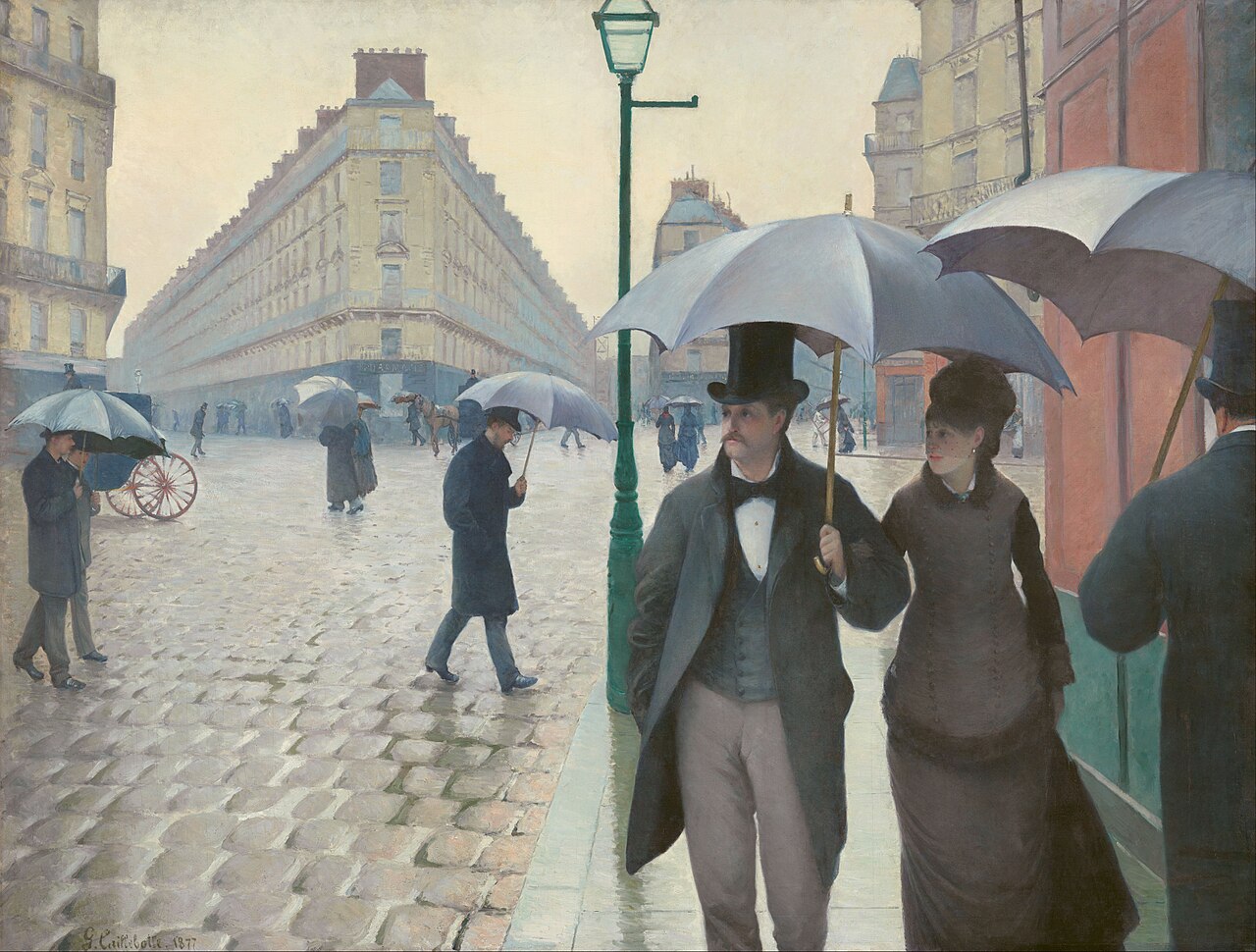
Caillebotte, Paris, A Rainy Day, 1877
An impression painting of as the title states a rainy day in Paris in which there are multiple figures holding umbrellas wandering the streets. A realist scene of everyday individuals, trying to get from place to another. The solid forms through outlining. The scene represents modern city life by showing foot traffic, an impressionist preoccupation. The composition is from a photographic gaze, feels like a snap shot as no one is posed, showing the spontaneity of the moment.. Time has been spent trying to capture light reflecting off different surfaces. The reflections on the wet cobblestones, the diffused gray light, and the softened details in distance show Impressionist interest. The lamp post splits the composition in half. The couple closest to the viewer is affluent see through their clothing. Beside the lady’s head is a worker.
Can be contrasted:
Monet, Boulevard des Capucines, 1874
Caillebotte represents Paris with sharp, realistic lines and clear figures. Monet represents Paris with dissolved forms, prioritizing light and optical perception. Caillebotte’s work is Realist-Impressionist hybrid; Monet’s is pure Impressionism. Caillebotte emphasizes composition and perspective; Monet emphasizes fleeting sensation.
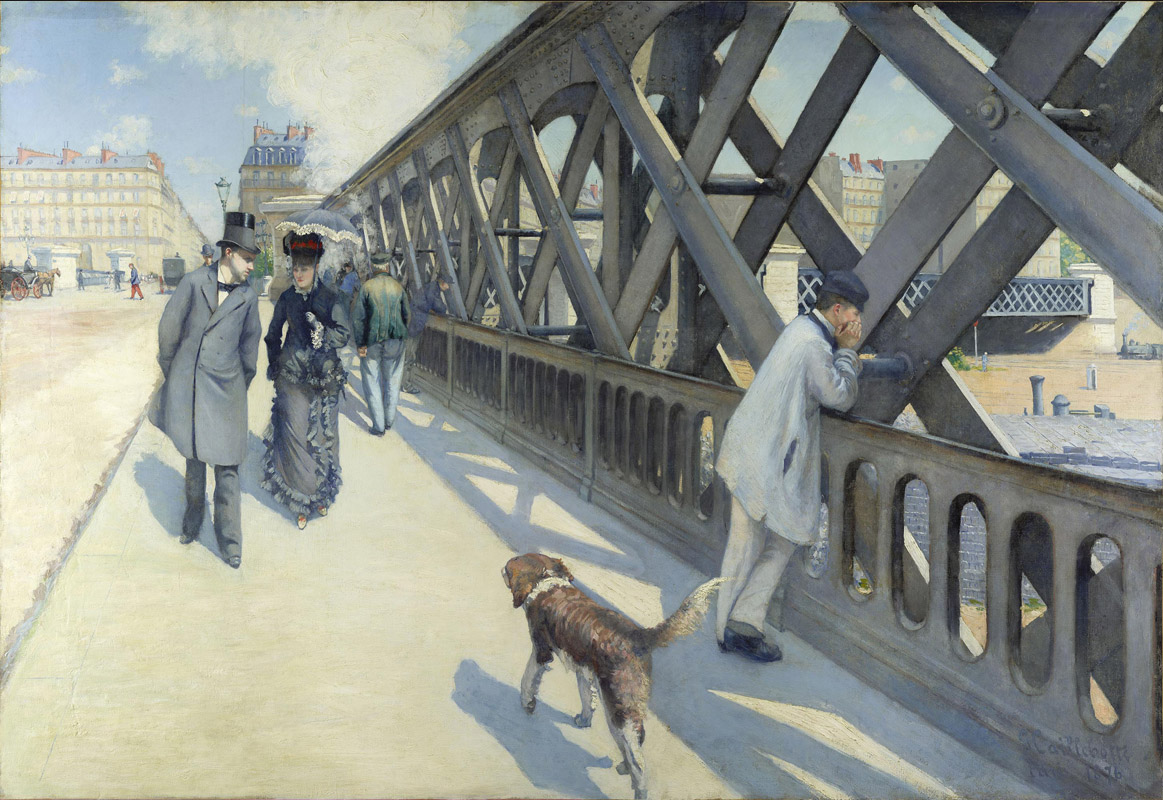
Caillebotte, Le Pont de l'Europe, 1877
Depicts a daylight scene in Paris as an affluent couple pass by a man who leans over the metal bridge railing. Painted during Haussmannization, which created wide boulevards, massive train stations, and new iron bridges like the one in the painting. The bridge overlooked the city’s major railway hubs, symbolizing industrial progress. The painting captures a key vision of modernity such as the mixing of crowds, steel constructions, industrial smoke, and social classes moving through public space. A realist element is the attention to social class distinction like the affluent couple, identifiable by their elegant clothing and the working-class figure in a blue smock, revealing class distinction in modern Paris. The man in a top hat represents the flâneur, the privileged observer of modern life. Another figure, leaning on the bridge, embodies the badaud, the passive watcher with no agency. The painting captures a specific moment of light, weather, and atmosphere, a central Impressionist concern. The mixture of steam, cloud, and industrial smoke creates ambiguity between natural and human-made forces, an Impressionist fascination that Monet also explored. The dramatic cropping, such as the dog with its paw cut off, creates a sense of immediacy, motion, and photographic spontaneity. The viewer feels as if they are walking into the scene, guided by the dog and the forward-moving figures. Caillebotte captures the modern experience of speed, an optical effect characteristic of Impressionism. The focus is on everyday life, not mythology or historical narrative.
Can be compared:
Manet, Rue Monsieur-le-Prince Decorated with Flags, 1878
Depicts the day after a festival, flags flying here, a scene meant to signify patriotism of the french republic but not everyone was pleased, the repression and destruction. Both works depict modern Paris and highlight the mixed emotions surrounding the new French Republic and the aftermath of political violence. Manet shows a street decorated after a festival, using light, flattened space, and everyday subjects. Like Caillebotte, Manet includes a working-class figure (one-legged man), referencing recent political conflicts. Both artists attempt to elevate everyday modern scenes, showing the city as it truly is rather than in idealized form. Both paintings show immediacy through quick, summarizing brushwork and the inclusion of marginalized/ordinary figures. Caillebotte focuses on industrial architecture and class distinctions, while Manet focuses on the emotional aftermath of political violence and everyday urban rhythms.
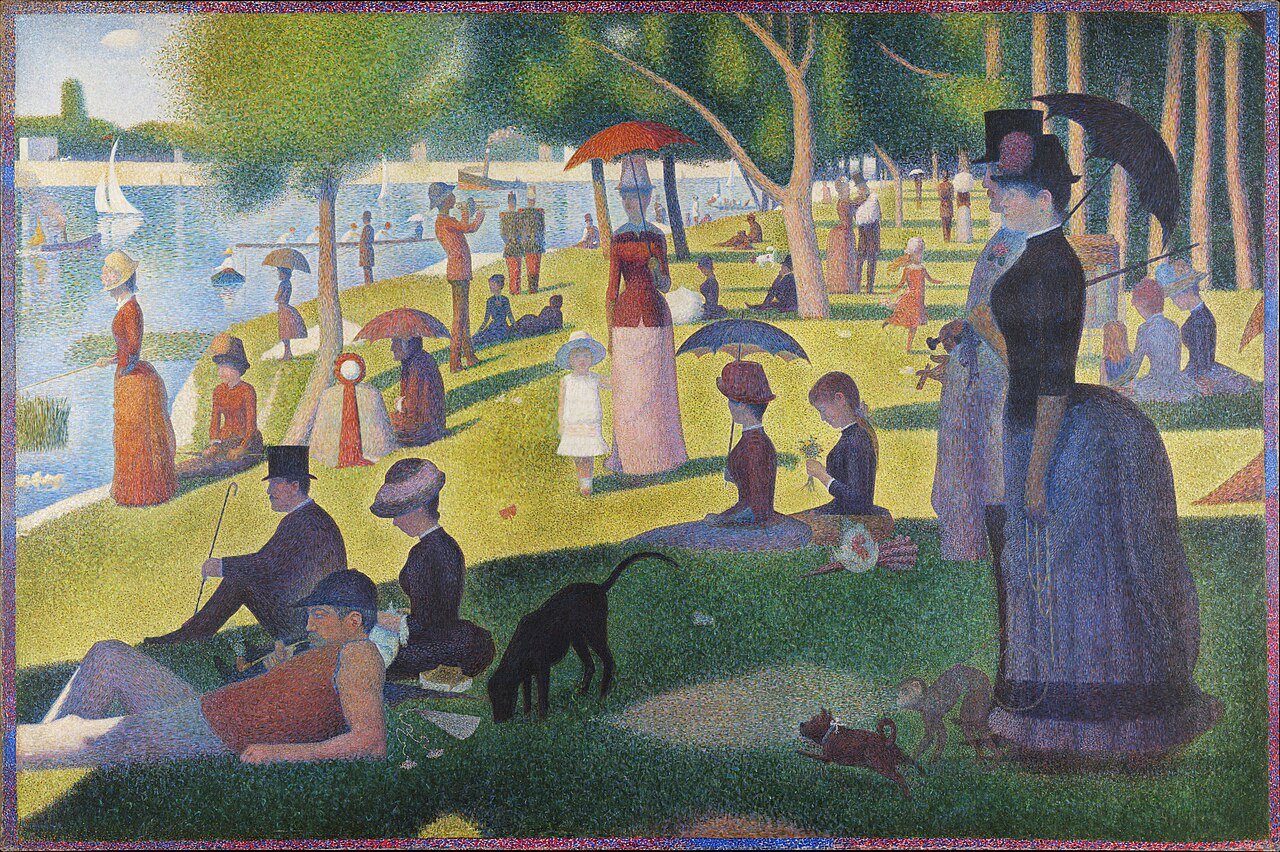
Seurat, La Grande Jatte, 1886
The composition is monumental which is uncommon as it is not a historical or myth painting. Uses pointalism to depict a Sunday outing of bourgeois families, soldiers, wet nurses, laborers, pets and boats at an island west of Paris. There is a shift in the colour from the left to right to capture the effect of light. This painting has many neo impressionist elements. The scene is frozen and there is no movement depicted. Everyone is separate in the composition outlined by dark contours. The differentiation between figure and background is rational. It was shown at the final impressionism show as a statement by seurat. The stereotype of the flaneur is because the viewer is the one observing others.
Can be contrasted to:
Manet, Music in the Tuileries, 1862
Captures the lively immediacy of modern Parisian leisure through loose brushwork, overlapping figures, and a spontaneous, sketch-like atmosphere that immerses the viewer in the crowd. In contrast Seurat’s, freezes modern leisure into a rigid, carefully structured scene where figures become still, monumental, and emotionally distant through pointillist technique. While Manet emphasizes the fleeting chaos and sociability of urban life, Seurat imposes scientific order and calm, transforming the same subject into a controlled, almost timeless tableau.
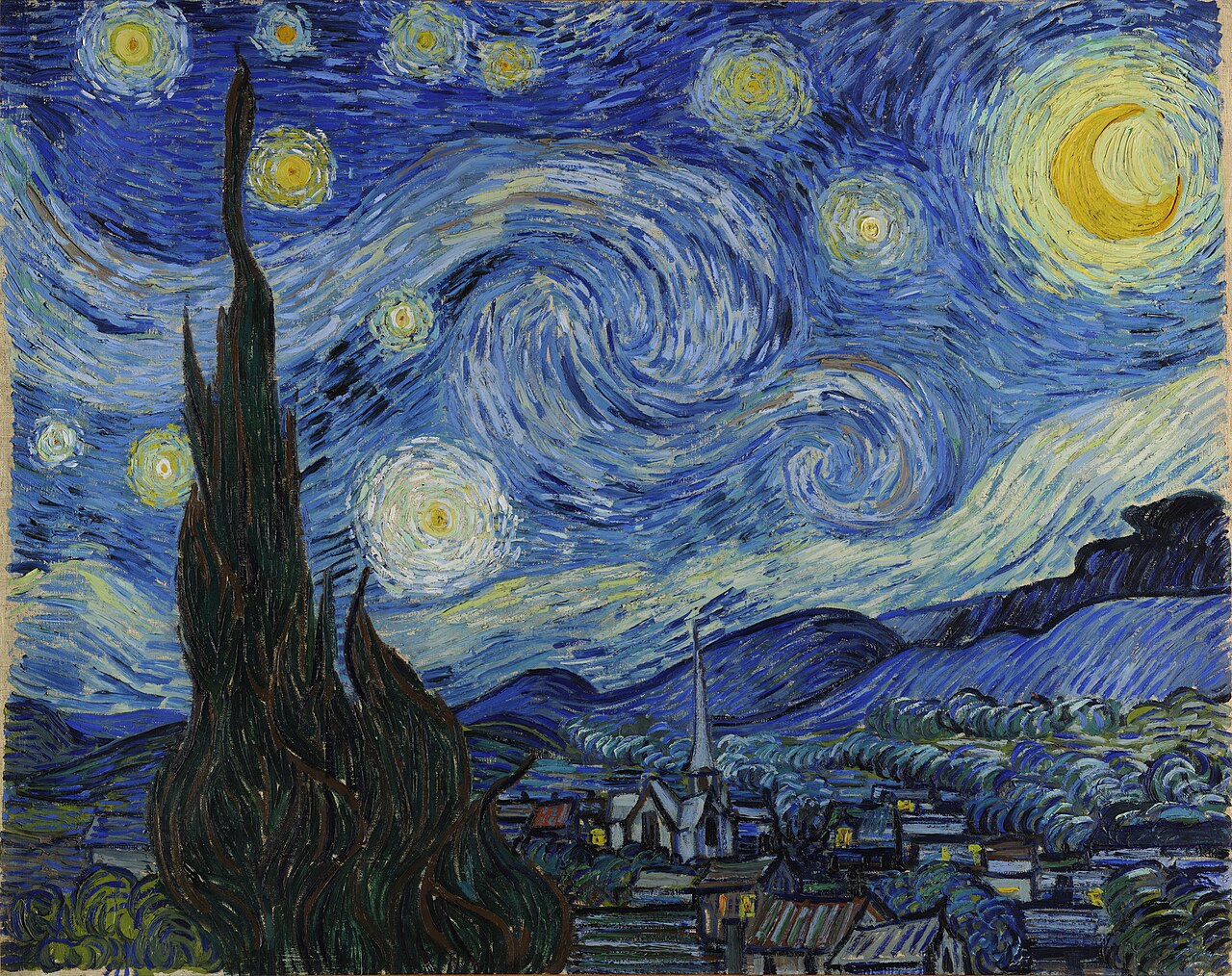
Van Gogh, The Starry Night, 1889
The high viewpoint of the city makes it ambiguous and gives it a mystical quality. The tree is a cyprus, seen only in graveyards. There is preoccupation with death and mourning. The painting is set in the night time. There is a swirling motion seen in the paint for expressive purposes. Based on a real place in Saint-Rémy, a realist element. There are many visible post impressionist elements. The sky moves in spirals and currents, created by thick impasto. The night sky is not realistically blue, rather it is more vibrant. Van Gogh uses colour to express emotion rather than what he sees. There is an element of fantasy seen in the stars and the moon, the northern star is located on the left side, much brighter than the rest. There is influence from historical dutch painting seen from the low horizon. Below the sky is a mountain range, with rounded mountains a reference to the Alpelas. The white closing in over the mountains is meant to be mist.
Can be contrasted:
Delacroix, The Death of Sardanapalus, 1827
Uses dramatic, non-naturalistic color to heighten emotion, the colour is chosen for expressive power rather than factual accuracy. Van Gogh was deeply inspired by this Romantic approach, and in Starry Night he similarly rejects descriptive realism, using heightened blues and explosive yellows to convey inner turmoil and spiritual intensity rather than a literal night sky. While Delacroix dramatizes historical violence through swirling reds and dynamic composition, Van Gogh translates that emotional colour theory into a cosmic, personal vision where the sky itself becomes a site of expressive upheaval.
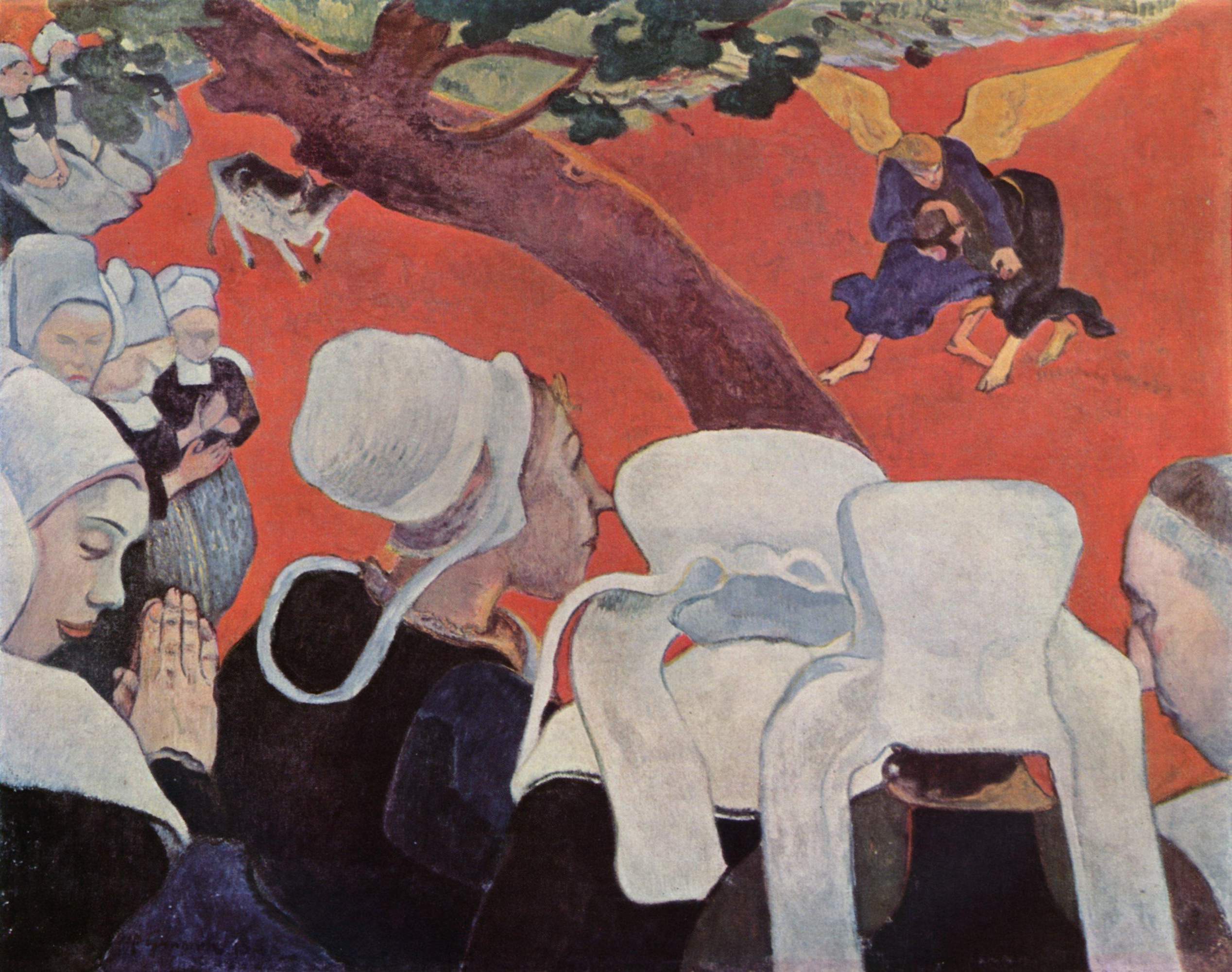
Gauguin, Vision after the Sermon, 1888
Depicts Jacob fighting the angel Gabriel in the book of genesis in the old testament. The perspective is distorted if there is a tree in the centre, a cow in the left corner is smaller and the women dominate the composition as Jacob and Gabriel fight in the left in the corner. The women are inspired from an area of rural France called Breton in which they have their own spiritual beliefs of which women were thought to be able to have visions due to their spiritual purity. This element strays from the impressionist preoccupation with modernity. The entire background is painted red, to symbolize the heightened spiritual state of the worshippers. Likely inspired from japanese wood black print, specifically Hiroshige. The bonnets have cords that drop down which Gauguin uses to play with their linear lines. There is an effort to convert an old religious text into something modern by taking ordinary people and relating them to religion.